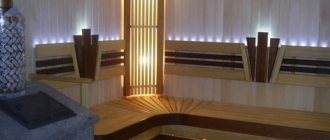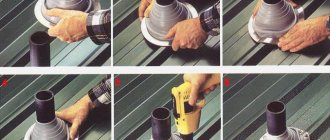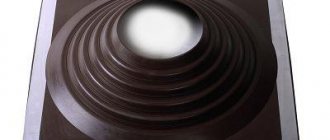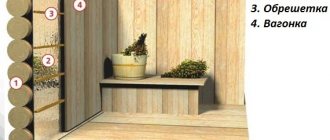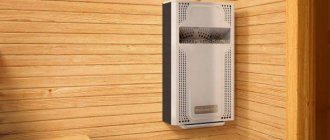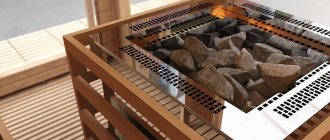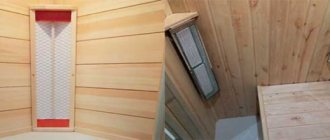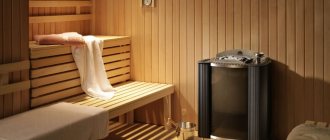There is no natural light in baths and saunas. Using conventional light bulbs is not always rational and safe. A way out of this situation is LED thermal tape. This type of lighting is functional and modern. Before carrying out, you need to study the features of proper installation and tips for use.
Is heat-resistant LED strip dangerous?
Every establishment owner is concerned about the safety of their lighting. Therefore, more and more people are inclined to use heat-resistant LED strips in saunas. The structural elements of the strip are protected from moisture; immersion in water is permissible (the main part, without connection ends).
Power is supplied by low voltage direct current (12 V). Such tension is safe for humans; staying in the steam room will not harm the body.
Conventional light bulbs require grounding when installed. And the LED version, if a stripe breaks down, is not dangerous to humans, electric shock will not occur.
Useful video on the topic:
Installation procedure
Install the tape in the following order:
- Calculate the total power of the structure.
- Install a power supply with a power reserve of 15-20% outside the steam room and wash room (in the rest room or dressing room). They also put a switch there.
- Connect the tape to the controller according to the designations B, G, R, V+.
- Clean, degrease and insulate the surfaces for installing the tape.
- Remove the protective film and fix the ice tape on the surface. If you need to shorten it, cut it off in the marked places with stationery scissors.
- Connect to the power supply, being sure to observe the polarity.
It is clear that installing light in a bathhouse is not difficult. Spend a little time choosing equipment, installation and enjoy the result of your labors for a long time.
Features of creating lighting in saunas and baths
When lighting work is carried out, it is necessary to take into account the specifics of the room:
- The cable footage is calculated with a margin to avoid additional connections.
- The wire is pulled through the inside of the open line.
It is better to output power through rooms where there is no high humidity or temperature.
It is necessary to take into account the nuances when choosing an LED strip. It must be heat-resistant, that is, contain a certain coating, IP65, IP68 protection. The steam rooms use a heat-resistant type that can withstand elevated temperatures. And in the rooms where showers are located, the LED strip is sealed, preventing the flow of water.
Installation of LED strip for saunas and baths is easy. In rooms where there is no humidity (rest room, locker rooms), the tape is attached to an adhesive base, and in steam rooms and showers with special fasteners.
Maximum operating temperature
The silicone case itself provides additional protection from extraneous high temperatures. At the same time, it is very flexible and bends at any angle without any problems.
As a result, such illumination can be used in a wide temperature range - from -40C to +100C!
That is, using a bathhouse or sauna in a steam area will not affect its normal operation.
Those who do not believe in the endurance and heat resistance of such a product can easily conduct an independent experiment.
It is enough to boil a saucepan of water and place an LED thermal strip turned on at a nominal voltage of 24V.
You can cook it in boiling water until all the water has evaporated. The tape will feel quite fine.
Advantages and disadvantages
People perceive the sauna as a place where they can relax not only physically, but also mentally. Properly designed lighting will help make the procedure complete.
Heat-resistant LED strip has a number of advantages:
- Energy efficiency (consumption is ten times less than when using a conventional light bulb, 2 times less in comparison with the fluorescent version).
- Ease of installation and connection.
- Long operational period.
- Great glow.
- Variety of shadow designs.
- Contains the protection level.
- Safety for humans.
- Suitable for illuminating underwater space (swimming pool).
Heat-resistant tape, unlike other types, has no disadvantages. A regular LED strip operates at temperatures of -30 – +60 degrees. But in the sauna area, the bathhouse, the temperature is higher, so only a heat-resistant design is applicable. In it, the diodes are coated with two-component silicone, resistant to elevated temperatures.
We recommend videos on the topic:
How to cut, seal and fasten
Now let's take a closer look at the points regarding how to work with such LED backlighting.
Firstly, how to cut it correctly. After all, it is in matte silicone protection. Secondly, what can be used to hermetically seal the second cut end.
Indeed, the cover completely covers the entire tape, which is why the factory cut points are not visible. Let us remind you that they are indicated by special icons.
You'll have to experiment here. Measure the length of the backlight you need and use a utility knife to make an incision half the thickness of the “tube.”
The depth of the cut should be sufficient to see the outside of the substrate. Pull the silicone apart and look inside.
If you didn’t guess correctly and don’t see the cut mark, then move to the right or left and make another cut.
And repeat this until the treasured icon appears.
When you reach it, it is in this place that you cut off the thermal tape.
After this, this end with cuts must be sealed with silicone sealant and closed with a special plug.
It is recommended to pour a little sealant into the plug itself.
After drying, its excess can be easily cut off with a stationery knife.
What sealant should I use? Vinegar based is best.
It does not cause corrosion of copper traces on the substrate.
If you do not have factory silicone plugs or have run out, take an ordinary heat-shrink tube and place it on the end of the tape.
After that, pour silicone sealant inside again and seat the tube.
It is better to do this with a hairdryer, since fire changes the color of the heat shrink and it can become smoky.
This LED strip is attached to any surface using soft silicone brackets.
If you couldn’t find them on sale, use “liquid nails” type glue.
You can also use metal clips. Plastic ones are not always appropriate here. The main thing is to choose them correctly according to the diameter of the silicone case.
Choosing the correct location of the tape in the sauna
The location where the heat-resistant LED strip is attached in the sauna is determined by the safety of visitors and fire safety measures. Therefore, when installing the wire, you need to consider:
- Wire cross-section, which is purchased with a reserve, taking into account the specifics of the establishment.
- Avoid soldering areas that could cause a fire.
During installation, in addition to the strip, you will need:
- Adapter (installed every 5 meters of strip).
- Controller (if it is necessary to switch colors).
- A plug that is installed at the end of the ice tape with heat-resistant sealant.
- The connector is connecting (fastening is made with heat-resistant sealant).
Installation Rules
Although ice strips are powered from low voltage, the wiring must be of high quality and protected from moisture and high temperatures. For installation, heat-resistant cables RKGM or protective metal casings are used.
Power supplies and switches should be located in rest rooms (where there is low humidity and normal temperature), and not in steam rooms and showers (washing rooms), to minimize the risk of electric shock. You can connect a standard length LED strip of 5 meters to one block. It is sold in a reel. It is not worth extending it, this may lead to loss of performance, but you can connect several pieces in parallel without loss of efficiency according to the circuit.
To connect a color LED strip, you will need an RGB controller that performs the function of switching colors.
Electricity input is best done through an RCD (residual current device). It will protect against current leakage. That is, if a violation of the network insulation occurs and the current begins to flow to the ground, there will be a threat of electric shock. The RCD will open the power circuit, thereby eliminating the danger.
After the RCD, a power supply is connected, which converts the voltage of 220 V 50 Hz into constant 12 V. The power of the converter must be higher than the total power of the ice strips. Typically, 10 A is sufficient for 5 meters. A plug is installed at the end of the tape using heat-resistant sealant. The connecting connectors are also secured and insulated with heat-resistant sealant.
LED strip lighting options
The placement of ice strip lighting is available in several options, each of which brings individuality to the room. A cozy atmosphere is achieved by highlighting the shelves and backs with blue and white tape.
It is not recommended to backlight in red; it looks aggressive and annoying.
At the same time, illumination can be carried out with other lighting devices. You just need to take into account that they are also heat-resistant.
Each shade gives the room personality. Just don’t overuse it and hang too many stripes, and even in different shades. This will only frighten visitors and prevent them from relaxing.
What lamps can be used
When choosing lamps, first of all you need to pay attention to the dust and moisture protection class. The higher the class, the better. The ideal option is IP68. It is necessary to choose lamps whose housing construction does not use plastic or other materials that cannot withstand high temperatures. The best case is made of iron, ceramics and glass. Such materials withstand heat well and are suitable for baths. Lamps must be protected from moisture by sealing gaskets on threaded connections. Wall lamps with an E27 base from Lindner are suitable; they are very popular and are used in saunas.
Built-in spotlights in the floor and benches are allowed. To add mystery to the atmosphere, you can cover the light bulb with a platband or hide the lighting fixture under a wooden lampshade. You can install an ice lamp of a suitable base in any of the lamps described above.
Tips for using diode strips for a bath
If the installation is carried out in accordance with all the rules and regulations, then no additional maintenance is required, and the structure will last a very long time. But in order to increase the operating period, it is worth considering a few tips:
- All thermal strips must correspond to the temperature conditions of the room.
- Installation is carried out in places that exclude the touch of visitors.
- The location should minimize aggressive effects (not near the boiler, ceiling, etc.).
Why can't LEDs be used in a bathhouse?
First of all, let's figure out why LEDs as such cannot be used in a bathhouse, and what the limitations are. At the same time, we immediately note that LED lamps can be used in washrooms, rest rooms, and swimming pools with almost no restrictions. The restrictions apply only to the steam room.
| The steam room is primarily about temperature. In a good “dry” sauna, the temperature can rise to 110⁰C, and some steam lovers reach the temperature a couple of tens of degrees higher. |
| For an ordinary LED lamp with operating temperature limits from minus 10 to plus 50-60⁰С, this is clearly overkill. If desired, you can look for LED lamps or strips with a maximum operating temperature of up to 100⁰C. But you definitely won't find it higher. |
| In addition, the steam room is about humidity. It is not for nothing that this room, according to the PUE standards, is considered particularly wet. Indeed, especially in “wet” baths, the humidity level in the room can reach 100%. Not every lamp can withstand this. |
| At the same time, a simple LED lamp usually has an IP20 level, which tells us that it cannot be brought even close to such rooms. Again, for the steam room, and for other rooms in the bathhouse, you should look for lamps with a higher level of dust resistance, but most importantly, moisture resistance. |
IP abbreviation table
Note! The abbreviation IP stands for level of protection against dust and moisture. The first number indicates the level of protection from dust, and the second from moisture. The higher the number, the higher the protection. For dust protection, numbers from 0 to 6 are used. For moisture protection, numbers from 0 to 9 are used.
Subtleties of lighting installation
There are several general rules to follow:
- The lamps are placed in such a way that during procedures you do not touch them with your head or hands. It is very conveniently located on the ceiling around the perimeter of the room, as well as on the walls, at half the height. Also, lighting is installed under or above the shelves, near the floor;
- one additional light source is hung above the front door;
- at any point in the room, light rays should not hit the eyes. Requires soft, diffused light;
- It is not recommended to use lamps with a color temperature that is too high or low. In the first case, bluish, harsh lighting completely kills the feeling of warmth and comfort. And in the second, the reddish and deep orange gives the depressing impression of an underground bunker;
- the brightest lighting is required for the rest room, dressing room, shelves;
- Excessive amounts of lamps harm vision and create discomfort.
An excellent solution would be lighting fixtures with adjustable light saturation. To do this, install several switches or install dimmers. Also, products with motion sensors that light up and go out as needed, saving energy, will not be superfluous.
Proper and safe lighting placement
In addition to the reliability requirements of the light sources themselves, it is important to place them safely.
- You should not place lamps near the stove: hot air will quickly destroy them.
- It is recommended to install wall lamps at an average level: those mounted too close to the ceiling or floor will collect more moisture and condensation.
- Ceiling lamps should not touch people's heads. Therefore, it is recommended to hang ceiling lamps in the corners of the bathhouse.
- The angular location is also good because the lamps shine from behind people’s backs: the light source does not blind the eyes.
- You should not place light sources where you can hit them.
Types of lamps
The following types of lamps for baths and saunas are available on the market:
- using incandescent lamps;
- LED lighting fixtures;
- fiber optic systems.
Bath and sauna lighting using classic incandescent lamps
The body of luminaires using incandescent lamps must withstand high humidity and temperature. To protect the lamp from moisture, various seals are used that seal the space between the body and the lampshade. When choosing a lamp for a bath, please note that its safety class must be at least IP56 (this protection class indicates that the lamp does not allow moisture to pass through).
Bathroom lighting using incandescent lamps
In bath lamps you can use incandescent lamps with a power of no more than 60 W. You can’t set the power to high, because they get very hot. Considering that the walls are covered with wooden clapboard and they are already heated to fairly high temperatures from the stove, then the added tens of degrees from the lamp can cause a fire.
LED lamps for baths
These lighting devices are absolutely safe, economical and reliable. Moreover, they are not afraid of moisture. Some of the specially designed models have a safety rating of IP65, which means that even if they are directly hit by a jet of water, they will not become a source of danger. The disadvantages of these lamps include the rather bright light, but proper placement and proper selection can turn this disadvantage into an advantage.
Bathroom lighting using LED lamps
There are some models that allow you to change not only the brightness of the light output, but also the color of the lighting using a special control panel. The range of LED lamps is wide, but the prices cannot be called low. But you can achieve the most unexpected effects: create a starry sky and play with colors.
Bathroom lighting using LED lamps
Fiber optic systems for bath lighting
The use of optical lighting systems is absolutely safe in any environment. The thing is that optical fiber only conducts light waves, not electricity. Therefore, such systems can be installed even at the bottom of a font or pool, creating incredible effects.
The fiber can withstand heating up to 200°C, which allows them to be installed even under the ceiling of a Russian bathhouse. They provide unsharp light, helping to create an atmosphere of comfort and relaxation. If we add cost-effectiveness, durability and ease of installation to the list of advantages, the growing popularity of these lighting devices becomes clear.
Bathroom lighting using fiber optics
Range
High-quality, efficient sauna lighting can be provided with various types of equipment:
- Incandescent light bulbs. Ceiling and wall lamps with a hermetic shell.
- LED. Light tubes and LED strips.
- Fiber optic. Projectors, fiber optic bundles and fiber optic lighting kits.
- Halogen.
- Accessories. Control panels. Wooden and steel grilles and lampshades, corner, wall, curly, etc.
- Himalayan salt. Lamps made from Himalayan salt create pleasant lighting and at the same time release beneficial substances into the air of a steam room.
Why LED lamps are not the best choice
It was noted above that LED lamps are not the best choice for a steam room. This is due to the design of the lamps.
Firstly, LED consists of semiconductor crystals that emits light. Their physical properties are such that they cannot work at high temperatures (above 100⁰C). But already at 60⁰С, the degradation of semiconductors begins. Therefore, the LED lamp will work, but not for long.
Secondly, LEDs heat up during operation. Heat is removed from them convectively using a radiator. But the temperature in the steam room is extremely high - the heat cannot escape from the lamp. This is the second reason for the rapid deterioration
Considering its considerable cost, there is no point in installing them in a steam room. It is better to make do with other options for bath lamps.
In other rooms, LED lighting is acceptable.
